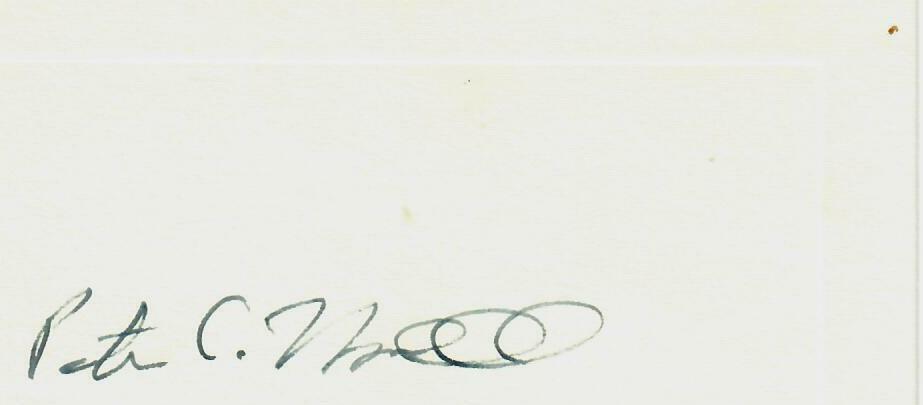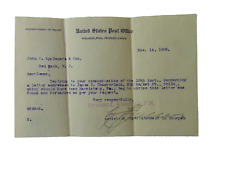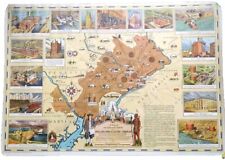RARE “Philadelphia Chromosome" Peter Nowell Hand Signed 3X5 Card For Sale

When you click on links to various merchants on this site and make a purchase, this can result in this site earning a commission. Affiliate programs and affiliations include, but are not limited to, the eBay Partner Network.
RARE “Philadelphia Chromosome" Peter Nowell Hand Signed 3X5 Card:
$489.99
Up for sale the "Philadelphia Chromosome" Peter Nowell Hand Signed 3X5 Card.
ES-4787
Peter
Carey Nowell (February 8, 1928
– December 26, 2016) was a cancer researcher and co-discoverer of the Philadelphia Chromosome. At the time of his death, he was the Gaylord P.
and Mary Louise Harnwell Emeritus Professor of Pathology and Laboratory
Medicine at the University of Pennsylvania.
Peter Carey Nowell was born in Philadelphia. His mother was a writer and a
teacher, and his father was an electrical engineer for the Bell Telephone Company. He
received a bachelor's degree in biology and chemistry from Wesleyan University in
Middletown, Connecticut, in 1948 and a medical degree from the University of Pennsylvania in
1952. He joined the Navy, and during his tour
he conducted research at the Naval
Radiological Defense Laboratory in San Francisco. He joined the
University of Pennsylvania faculty in 1956. At the time of his death he was
chairman of the department of pathology and laboratory medicine at UP. In 1952
Nowell married Helen Walker Worst. They had five children. His wife died in
2004. Nowell died in Philadelphia, Pennsylvania. Nowell
credits his ultimate discovery of the so-called Philadelphia Chromosome to an
accident he made while cleaning a research slide. While working in a laboratory
at UP studying samples of chronic myeloid leukemia,
he happened to wash his slides with tap water instead of a laboratory solution.
When he then studied the slides under his microscope, he saw that the water had
caused the cells' chromosomes to expand. This was
unusual, but since at that time chromosomes were not considered part of the cancer-causing
puzzle, he could have disregarded the anomaly. Instead, he decided to
investigate (he said later, "I didn’t know anything about chromosomes, but
it seemed a shame to throw this away.") He partnered with David Hungerford (1927-1993), a graduate student at
the Fox Chase Cancer Center in
Philadelphia. Analyzing the white blood cells of patients with this particular
form of leukemia, Hungerford consistently noticed that the Chromosome 22 was noticeably short. The finding was a
turning point. Until then, most scientists believed viruses to be the cause of
cancer. This new avenue of research fueled decades of scientific research that
produced monumental steps in the treatment of cancer. Gradually, technology
improved enough to allow scientists to visualize the genetic material in
greater detail. Janet D. Rowley, a
University of Chicago researcher, determined the chromosome to result from a
translocation, in which portions of two chromosomes exchange places, causing
cells to turn malignant. Alfred G. Knudson Jr., a geneticist at Fox Chase, made
further progress linking genetics and cancer. In 1998, Nowell, Rowley and
Knudson received Lasker
Awards for their combined work in this area. At present, drugs
have been developed that hold chronic myeloid leukemia in remission for years.
Nowell received his B.A.
from Wesleyan University in
1948 and his M.D. from the University of Pennsylvania in
1952. He spent two years in the US Navy studying radiation and bone marrow
transplantation and then returned to UPenn where he joined the faculty in 1956.
He served as chair of the department of pathology from 1967-1973, and as the
first director of the University of Pennsylvania Cancer Center, now known as
the Abramson Cancer Center at
the University of Pennsylvania. In
1960, Nowell and his graduate student David Hungerford discovered the
Philadelphia chromosome, an abnormally small chromosome in the cancerous white
blood cells of patients with chronic myelogenous
leukemia. This discovery was a critical step in showing that cancer has
a genetic basis, contrary to a widespread belief at the time. This information made the development of imatinib and other targeted therapies possible. In the
1960s, he published that phytohemaglutinin was capable of triggering mitosis,
which allowed scientists to grow cells in culture for the study for cancer.

Related Items:
RARE “Philadelphia Chromosome" Peter Nowell Hand Signed 3X5 Card
$489.99
RARE "Philadelphia Post Office Superintendent" Lawrence Fuller Signed TLS
$69.99
Philadelphia Electric Company Vintage Illustrated Map 1950 J RIEGEL JR Rare
$449.99



